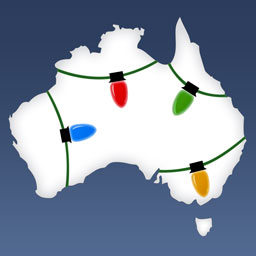Notenoughlights
500,000+ twinkly lights
This will just be brief for now as I don't have any photos of the finished product up close yet.
Parts list at the bottom of this post.
I decided to build seed pixel icicles for two reasons.
1: After seeing the LED curtains that were on the market, I thought these could be adapted to become a form of small but very long matrix, as the icicle format wasn't the usual 4-5-7-6-5-4 for example. I still called them icicles because they were hanging and not fixed to create a grid pattern (The icicles I made did not have this drop pattern, they were all 10-10-10-10-10 drops).
2: Bullet pixel icicles were rather expensive and I needed a lot, they were also very big and bulky, harder to repair if there was a faulty pixel mid-string.
Designing phase
I needed a way that wouldn't involve cutting and soldering potentially 2600 or more bits of 100mm wire. I had a string of seed pixels on hand, and looked at how small the wires were, and tried to see if an RJ45 connector would fit on the end and crimp with a secure grip, it turns out, they worked perfectly. April 2023, I ordered 400 RJ9 crimp on connectors, 5000 seed pixels with return data wire (these had been a back and forward conversation with Knowshine to get this made properly from about January) and 500 RJ9 PCB mount sockets. At the time I was talking with Artacus on the WLED discord server You can read his build story here and we came up with an idea of PCB's to keep everything spaced correctly, he designed the PCB and I had 100 made and shipped to my door, these were just over $100 shipped.
Building
I discovered I had ordered 500 of the wrong type of RJ9 pcb socket, but it turns out that flipping the PCB over so the RJ9 socket was soldered onto the back of the PCB allowed everything to work just fine.
The icicles were constructed with 100mm spacing between each RJ9 socket, every second one was skipped and a jumper link soldered in place between data in/out on the PCB for the skipped socket.
The next part was finding a way to waterproof these but not make it clumsy and awkward to install.
My mind went to 25x25mm electrical ducting/trunking. This was a bad idea, the weight of the trunking made it very difficult to install with just one person, the fact I would have to drill out every single LED strand so it would hang out of the trunking, and the fact it was just ugly hanging on the front of the house, cause me to ditch that idea the same day I had it.
My next idea was to spray every PCB with conformal coating. That idea also went nowhere once I found out the price for the stuff, and how much I would need.
3rd time lucky, I had a look on Bunnings website, found the perfect thing for the perfect price, paint on waterproofing membrane, safe for water collection. I bought a 1L tub, threw in my multimeter probes to check it wasn't conductive just incase, it wasn't.
Next few weeks were spent painting 75 PCBs with 3 layers each, very messy process, I would suggest you do this outside or have plenty of paper.
In between soldering the PCB's I was cutting, crimping and soldering the data return to data out wires for approximately 500 icicle strands (I wanted some spares, and also had plans to extend and add icicles elsewhere later on)
Installation
I hung a few bare PCB's painted with the waterproofing compound out earlier than needed to check that they would perform OK in the sun/rain/wind/whatever nature were to throw at them.
Nothing happened that caused any negative effects. Yay, out went the rest.
I needed a way to keep water out of the RJ9 plugs should rain get carried by wind etc, as they were not waterproofed from below. Silicon grease was too expensive for the amount I needed, Lithium Grease was my next option, this was spread onto every plug before the icicle strand was clipped in.
Testing
The videos speak for themselves
Testing text on the icicles
Running them with a sequence for the first time
First installation basic testing
There were seed led failures during the 2023 Christmas lighting season, the RJ9 plugs/sockets made fixing a dead pixel one of the easiest repairs ever done on my light show, less than 10 seconds to get it all up and running again (after getting a ladder out and making my way through all the visitors)
Parts list:
PCB files:
View: https://drive.google.com/file/d/1h2z311PLfQ8Shdx0CPYPFvlwQIrODd8-/view?usp=drive_link
RJ9 crimp on plugs: https://www.aliexpress.com/item/32874879176.html?
RJ9 solder in PCB sockets: https://www.aliexpress.com/item/32797945817.html?
Seed pixels: https://www.aliexpress.com/item/1005005186143268.html? <-- Be sure to select the 4 wire version with return data wire
Exterior grade Waterproofing paint on membrane: https://www.bunnings.co.nz/crommelin-1l-exterior-grade-brushable-waterproofer_p0961573
Parts list at the bottom of this post.
I decided to build seed pixel icicles for two reasons.
1: After seeing the LED curtains that were on the market, I thought these could be adapted to become a form of small but very long matrix, as the icicle format wasn't the usual 4-5-7-6-5-4 for example. I still called them icicles because they were hanging and not fixed to create a grid pattern (The icicles I made did not have this drop pattern, they were all 10-10-10-10-10 drops).
2: Bullet pixel icicles were rather expensive and I needed a lot, they were also very big and bulky, harder to repair if there was a faulty pixel mid-string.
Designing phase
I needed a way that wouldn't involve cutting and soldering potentially 2600 or more bits of 100mm wire. I had a string of seed pixels on hand, and looked at how small the wires were, and tried to see if an RJ45 connector would fit on the end and crimp with a secure grip, it turns out, they worked perfectly. April 2023, I ordered 400 RJ9 crimp on connectors, 5000 seed pixels with return data wire (these had been a back and forward conversation with Knowshine to get this made properly from about January) and 500 RJ9 PCB mount sockets. At the time I was talking with Artacus on the WLED discord server You can read his build story here and we came up with an idea of PCB's to keep everything spaced correctly, he designed the PCB and I had 100 made and shipped to my door, these were just over $100 shipped.
Building
I discovered I had ordered 500 of the wrong type of RJ9 pcb socket, but it turns out that flipping the PCB over so the RJ9 socket was soldered onto the back of the PCB allowed everything to work just fine.
The icicles were constructed with 100mm spacing between each RJ9 socket, every second one was skipped and a jumper link soldered in place between data in/out on the PCB for the skipped socket.
The next part was finding a way to waterproof these but not make it clumsy and awkward to install.
My mind went to 25x25mm electrical ducting/trunking. This was a bad idea, the weight of the trunking made it very difficult to install with just one person, the fact I would have to drill out every single LED strand so it would hang out of the trunking, and the fact it was just ugly hanging on the front of the house, cause me to ditch that idea the same day I had it.
My next idea was to spray every PCB with conformal coating. That idea also went nowhere once I found out the price for the stuff, and how much I would need.
3rd time lucky, I had a look on Bunnings website, found the perfect thing for the perfect price, paint on waterproofing membrane, safe for water collection. I bought a 1L tub, threw in my multimeter probes to check it wasn't conductive just incase, it wasn't.
Next few weeks were spent painting 75 PCBs with 3 layers each, very messy process, I would suggest you do this outside or have plenty of paper.
In between soldering the PCB's I was cutting, crimping and soldering the data return to data out wires for approximately 500 icicle strands (I wanted some spares, and also had plans to extend and add icicles elsewhere later on)
Installation
I hung a few bare PCB's painted with the waterproofing compound out earlier than needed to check that they would perform OK in the sun/rain/wind/whatever nature were to throw at them.
Nothing happened that caused any negative effects. Yay, out went the rest.
I needed a way to keep water out of the RJ9 plugs should rain get carried by wind etc, as they were not waterproofed from below. Silicon grease was too expensive for the amount I needed, Lithium Grease was my next option, this was spread onto every plug before the icicle strand was clipped in.
Testing
The videos speak for themselves
Testing text on the icicles
Running them with a sequence for the first time
First installation basic testing
There were seed led failures during the 2023 Christmas lighting season, the RJ9 plugs/sockets made fixing a dead pixel one of the easiest repairs ever done on my light show, less than 10 seconds to get it all up and running again (after getting a ladder out and making my way through all the visitors)
Parts list:
PCB files:
View: https://drive.google.com/file/d/1h2z311PLfQ8Shdx0CPYPFvlwQIrODd8-/view?usp=drive_link
RJ9 crimp on plugs: https://www.aliexpress.com/item/32874879176.html?
RJ9 solder in PCB sockets: https://www.aliexpress.com/item/32797945817.html?
Seed pixels: https://www.aliexpress.com/item/1005005186143268.html? <-- Be sure to select the 4 wire version with return data wire
Exterior grade Waterproofing paint on membrane: https://www.bunnings.co.nz/crommelin-1l-exterior-grade-brushable-waterproofer_p0961573
Last edited:


